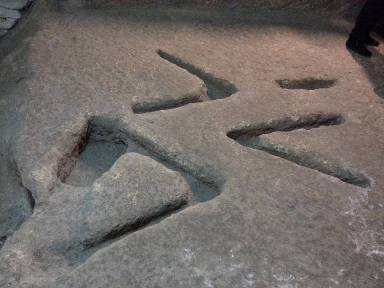
The “mysterious markings”
In December 2015 my wife and I were privileged to be shown an archaeological site in the City of David that is not generally open to the public. Within this site were found the “mysterious markings” that had been publicized by the Ir David Foundation, a natural stone pillar, or matsebah, placed in a base of twelve stones, and a small olive oil press. Upon returning home and studying the photographs of the mysterious markings, I was blessed to understand that they were actually Paleo-Hebrew letters, beit and jot, which together mean “House of God.” My translation of the markings was then confirmed by Dr. William Welty, a scholar of ancient languages.

The archaeological site is located on the eastern side of the hill that is the City of David, and is thought to precede the time of King David by as much as one-thousand years. It is perhaps one hundred feet, or more, beneath the level of the City of David and is within thirty feet of the discovery of the Gihon Spring. However, there were things about the site that troubled me.
Perhaps the first was that it was located underground. However, I later realized that this is explained by the fact that, according to the historian Josephus, when King Solomon built the large plaza for the Temple of God, it resulted in an extension to the east side of the city. Solomon had to build a huge retaining wall adjacent to the Kidron Valley hold the fill needed to create the plaza. Josephus said that the wall was so high you would get dizzy looking down over it. Dr. Eli Shukron, who discovered the ancient site, said that it had been carefully filled with layers of dirt and gravel. This was due to Solomon’s efforts to create a stable base for the plaza and the Temple that he would build above the site. This also explains why the Gihon Spring was buried and was not discovered until 1997.
The next thing that troubled me was the similarities in the site in the City of David marked “House of God” and another location, thought to be about ten miles north of Jerusalem, named Bethel or “House of God.” Bethel was so named by Jacob after he was given a vision by the Lord. Jacob erected the rock he had been using as a pillow, anointed it with oil, and stated that this must be the “House of God.” (See Genesis 28:16-19)
Because the location of Bethel has not been confirmed, I wondered if Bethel and Jerusalem could be the same place. However, both are named in the allotment of land given to the tribe of Benjamin in Joshua 18:21-28. Therefore, they cannot be the same.
Then I realized the difference between the two locations. Bethel was named by Jacob. It is composed of two Hebrew words, beit meaning house and el meaning God. But el is a title, not a name, and is used many times in the Bible in reference to many beings, not just the Lord God.
However the inscription found in the City of David, beit jah, means House of Jah. Jah is a contraction of the tetragrammaton, JHVH, pronounced “Jehovah” in English, and is not just a title like el, but is God’s name. The name Jah is found forty-nine times in the Old Testament. With the exception of Psalm 68:4, it is translated as “LORD” in the King James Version. This is all in capital letters to differentiate it from “Lord,” a title of deference used in addressing men. It is LORD, the name of the Lord God Jehovah.
Why is the difference between el and Jah important? The Lord made it clear that He would choose a place for His name. This was foretold in Deuteronomy 12:5, 12:11, 16:2 and 16:6. The culmination of the Lord’s choice is found when King Solomon was dedicating the newly-built Temple. In his prayer to God, Solomon said,
“That thine eyes may be open toward this house night and day, even toward the place of which thou hast said, My name shall be there:” – First Kings 8:29This prayer is repeated with slightly different phraseology in Second Chronicles 6:20.
The significant difference between Bethel and Jerusalem is that Jerusalem is the hallowed place where the Lord God chose for His name to dwell. Bethel was named by a man, in honor of God’s vision to him, but Jerusalem was chosen by the Lord Himself.
And Jerusalem is synonymous with the City of David. (Second Kings 14:20) And, the City of David is Mount Zion. Again this place, Zion, is the place the Lord chose to dwell. (Psalm 9:11, 48:2, 74:2, 76:2, 132:13) The Lord chose Zion, which is the City of David, which is the heart of Jerusalem according to the Word of God. The “clincher” and certainly the confirmation is the fact that within the City of David, the Lord has caused His name to be engraved in stone, in letters two inches deep into the bedrock and almost two feet across. This, clearly is the place chosen of God for His dwelling place!
If nothing else, the fact of the Lord’s name engraved in stone in the City of David should substantiate the true location of the Temple of God, first built by Solomon. (Please see The House of God – Click HERE) When the Lord chooses, I believe this truth will be revealed and His Temple will be built there. This may not be until the final Millennial Temple is constructed, but I look forward to the day. May the name of the Lord, engraved in stone in the City of David, be praised always!